By Francine Barone

If the number of cute animal memes on the internet is a fair benchmark, then the human love of pets is a powerful and global phenomenon. For many pet owners, their furry (or scaly) domestic companions transcend any simple categorization of non-human animal. Indeed, research shows that it is a growing global trend for pet owners to consider their animals to be full members of their families; to dote upon them as they would children or romantic partners, both emotionally and financially; and to thereby develop strong bonds of dependency, love, and support.
Gray and Young (2011) conducted a broad cross-cultural study of human–pet dynamics around the world utilizing the Probability Sample Files, a stratified random sample of 60 culturally, linguistically, and geographically diverse societies represented in eHRAF World Cultures. Their study revealed that “dogs, birds, and cats were the most common pets, followed by horses, other hoofed mammals such as water buffalo, rodents, nonhuman primates, and pigs” (ibid. 23). The authors suggest various reasons that peoples around the world keep pets, including rearing the animals for food, training them for assistance with hunting or labor needs, or keeping them as playful companions for children. Attitudes and sentiments towards the domesticated animals vary, with many societies attaching spiritual meaning to their birds, cats, or dogs that “illustrate the ways in which pets may be woven into the broader belief system of a society” (ibid. 26).
Regardless of the reasons for domestication, the emotional connection between pets and their owners is worthy of cross-cultural attention. For example, it has been discovered that dogs are able to read emotional cues from the faces of their owners and to respond accordingly. Other recent studies have shown that people tend to have more compassion for animals who are suffering than for adult humans in similar circumstances, treating the hurt dogs akin to helpless infants who need protection. Based on global data, researchers in this telling social experiment concluded that, by and large, subjects “did not view their dogs as animals, but rather as ‘fur babies’ or family members alongside human children”.
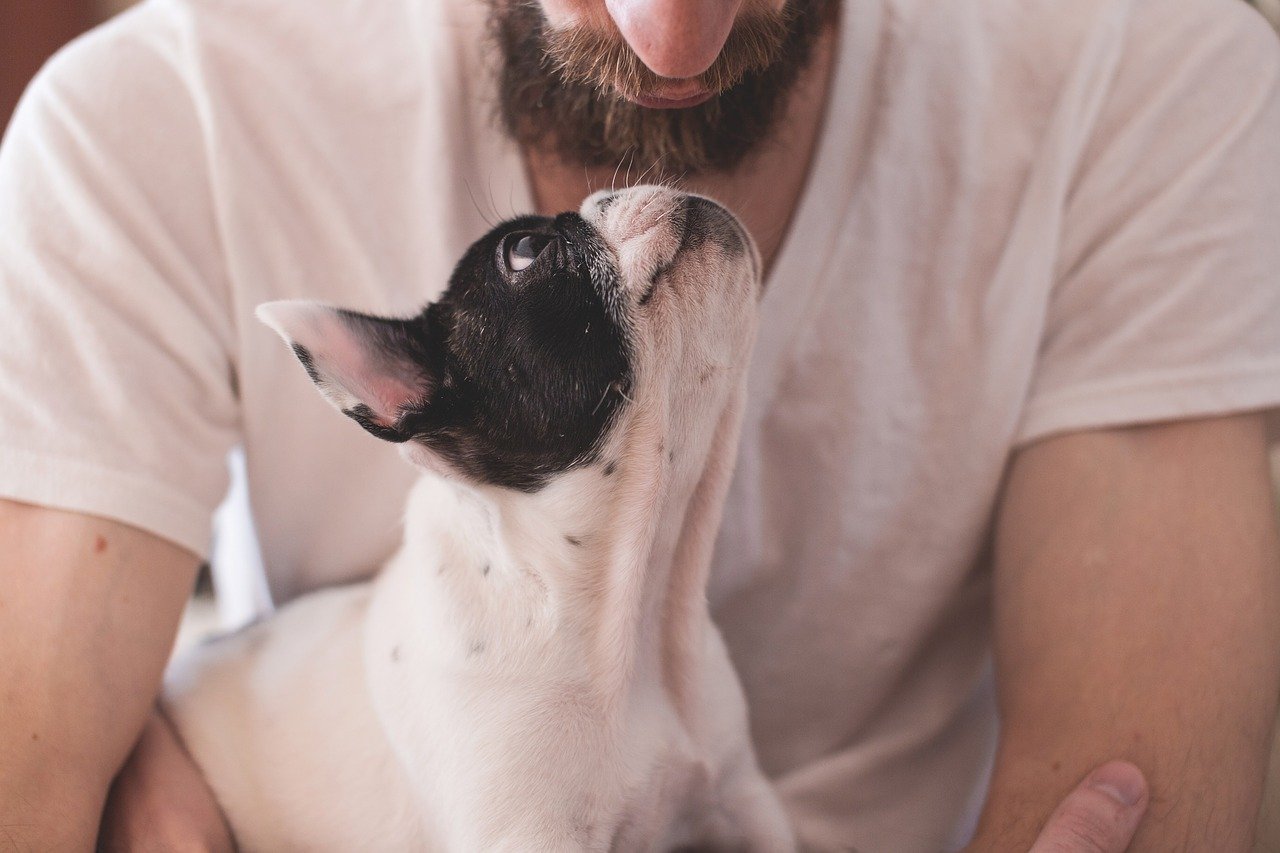
This post will explore the following question: what is the source of this capacity for our love of pets, and does it vary cross-culturally?
Archaeological and ethnographic evidence
As to the origins of human-pet relationships, anthropologists suggest that our propensity for keeping pets, as well as our finely honed empathy for their emotional state, stems from the process of animal domestication in early human history, beginning with dogs and continuing to horses, sheep, goats, and others:
In each case, humans had to learn to put themselves in the minds of these creatures in order to get them to do our bidding. In this way our senses of empathy and understanding, both with animals and with members of own species, were enhanced. Our special relationship with animals is revealed today through our desire to have pets (McKie 2011).
According to paleoanthropologist Pat Shipman of Pennsylvania State University,
Humans are the only species on Earth to have one-to-one relationships with a member of another species … No other creature would waste resources [in this way]. But we do, and that is because we have evolved such close ties with specific animals over the millennia and because we are adapted to empathise with other creatures. It is a unique human attribute. We get so much from animals, much more than we appreciate (ibid.)
Evidence of ancient burials from eHRAF Archaeology supports recognition of a longstanding bond between humans and animals far back into prehistory. For example, in ancient Egypt (5000-2000 BCE), Rice finds that, “amongst the graves at Helwan are examples of the burials of dogs and donkeys; as these do not seem to be the subject of cult or religious observance, it may be that they were family pets, since the Egyptians always kept animals about them, as members of their households” (1990: 131). Similarly, on the other side of the world, the purposeful interment of animals in prehistoric settlements is known throughout the American Southwest and northern Mexico. According to Woosley and McIntyre, at the Wind Mountain site in New Mexico dating back to 2000-600 BP, the animals buried included dogs, bears, turkey, golden eagles, hawks, mourning doves, and scarlet macaws (1996: 281). They ponder the reasons for these burials:
The underlying motivations compelling prehistoric peoples to inter certain animals remain enigmatic, but the archaeological context and associated artifacts of such burials, together with nineteenth and twentieth century ethnographic accounts and descriptive historical documents, provide some clues that the practice, at least in part, was related to ritual. It is equally likely, however, that certain animal burials denote pets given special treatment by their owners (ibid. 281; emphasis added).
With such a long history connecting humans and domesticated animals, does the same special relationship exist everywhere today?
Is fondness for pets a cultural universal?
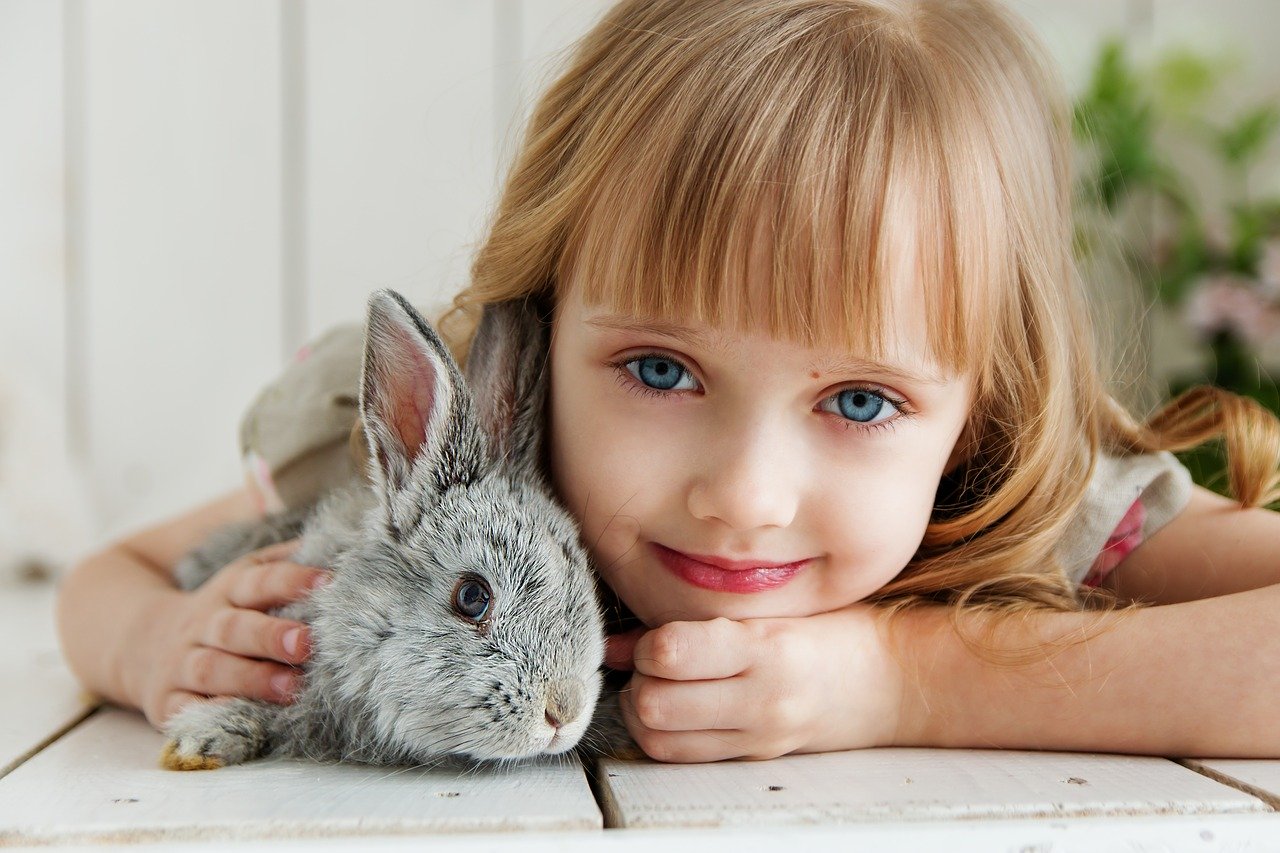
While the keeping of domestic pets appears to be overwhelmingly common, what makes an animal a suitable pet – and one worthy of great adoration and pampering by their human owners – can vary across cultures. Are some pets more beloved than others? Let’s explore some ethnographic accounts of love for animals from eHRAF World Cultures to see if unconditional devotion to one’s pets is truly a cultural universal.
Edmund Leach’s seminal work, “Animal Categories and Verbal Abuse” (1964), presents the human relationship to animals in terms of social distance. Attitudes towards different animals reflect our familiarity with them, so that the most familiar or “closest” to ourselves are subject to ritual provisions or prohibitions because they are considered “taboo”. They are also most worthy of human-like care and devotion. This is why people generally avoid eating the animals that they might also keep in their homes as pets. Conversely, those creatures physically or symbolically more distant from the self – i.e. animals in a field farther away from the home – can be seen as suitable food; and those yet more “wild” are too distant for even human consumption (Leach 1964: 52). Does this model of human-animal relations ring true around the world?
Dentan’s (1988: 329) description of Semai dietary restrictions in Malaysia gives insight into the categorization of animals as either loveable or edible:
On the one hand, there are tame animals such as dogs, cats and monkeys and, in the lowlands, semi-tame birds. The association the Semai have with these animals is under human control or, in the case of the semi-tame birds, not very intimate. These animals are “not eatable,” the Semai say, because “we love them.” On the other hand, there are wild but synoecious animals like house rats, cockroaches and rice weevils. […] These animals are “not eatable,” the Semai say, because they are “dirty” or “evil spirits.” The idea of eating them is disgusting.
The Semai example aptly illustrates Leach’s proposition regarding how humans categorize animals within the natural world and construct a model of social distance which aids in our understanding of human-animal relationships.
Fur Babies
The dynamic of intimacy in the human relationship to animals recurs in the ethnographic literature. The closeness of human-animal relationships is evident around the world with instances of beloved species being cared for as fondly and tenderly as human babies.
For example, the Amazonian Tukano people of South America enjoy the companionship of domesticated animals in their homes: “They have monkeys, birds, dogs, etc. They love and take care of these animals as if they were their own children, and to feed them when they are small, the native first chews the food before giving it to the animal to eat” (Fulop and Bravo 1954: 4). Additionally, while each home keeps chickens, they are reserved for bartering only. Neither the birds nor the eggs make up part of the local diet, which sources its protein from worms and ants instead (ibid.). In keeping with Leach’s model, the latter are edible because they are not lovable.
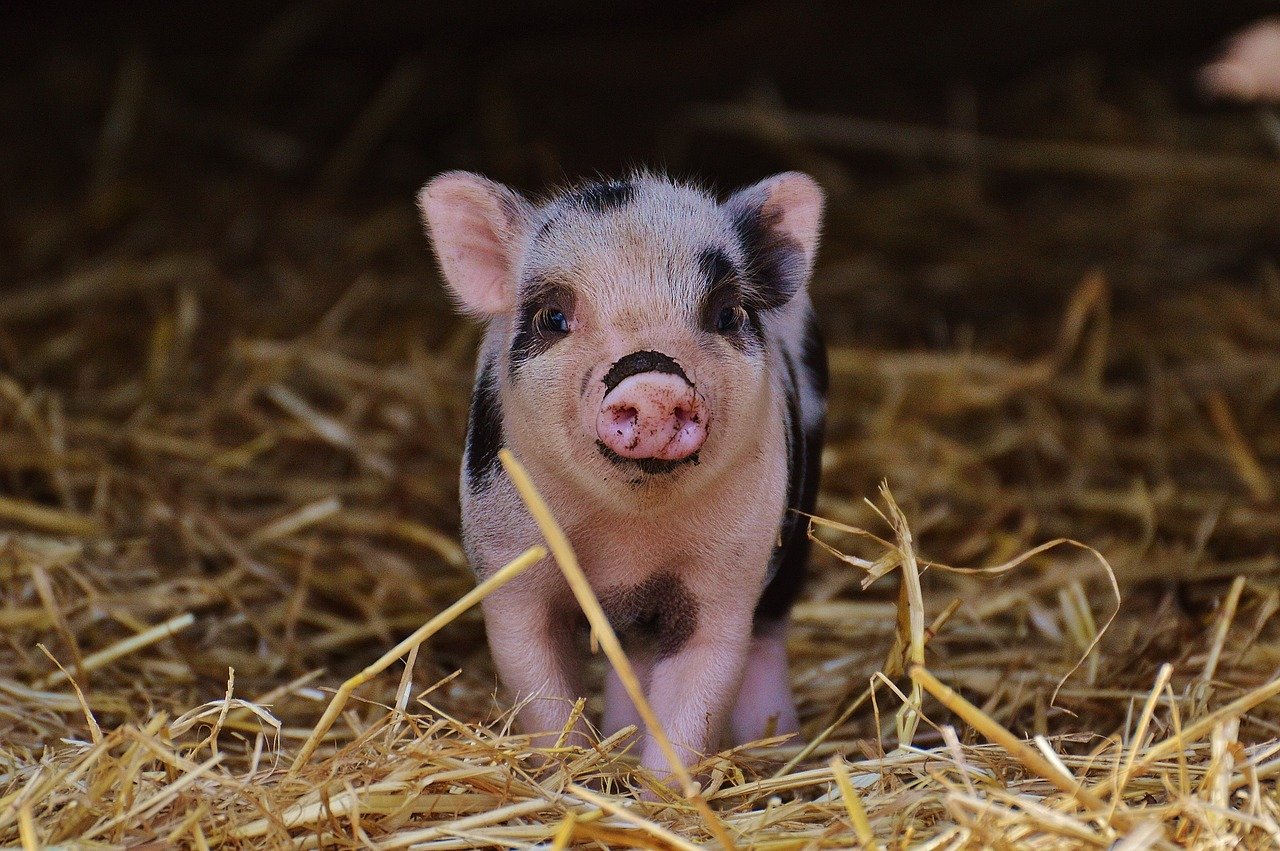
On the Pacific Island of Yap in Micronesia, an even closer parent-child relationship between human and animal is simulated in the case of piglets:
When a little pig is only a few days old, the Yap woman usually takes it away from its mother, who is rarely able to nurse it, and cherishes and protects it herself with a tenderness and solicitude bordering on the love given to a child. She does not shrink from nursing it if necessary. The “baby” soon becomes accustomed to its loving nurse and follows her every step (Salesius 1906:148).
So common is the adoration of these pet pigs that it is not unusual to see “a row of Yap women walking along in single file, some of whom carry their tired ‘babies’ in their arms, while their own offspring hang on their backs, and others have their frisky, jolly little lap-pig running along beside them, grunting and hopping in youthful exuberance” (ibid. 148-9).
Interestingly, pigs are not the only pets that are sometimes nursed by human women instead of their own mothers. Dogs are one of the most cherished animals around the world, and it is not uncommon for puppies to be raised alongside human babies, with the same attention and devotion.
Cipriani and Cox (1966: 21) comment on the passionate love for dogs found among the Onge people of the Andaman Islands: “Having once realized the usefulness of dogs, first imported into the islands some thirty years ago, the Onges now pet them like little girls with their dolls, and the Onge women will suckle the family puppies quite naturally with their own children”. The author hastens to add that once a dog passes away, “the other side of the Onge nature comes to the fore and the carcass is thrown into the forest – there is no looking back”. In this case, the adopted fur babies are still distanced from true family, despite being lovingly nurtured throughout their lives.
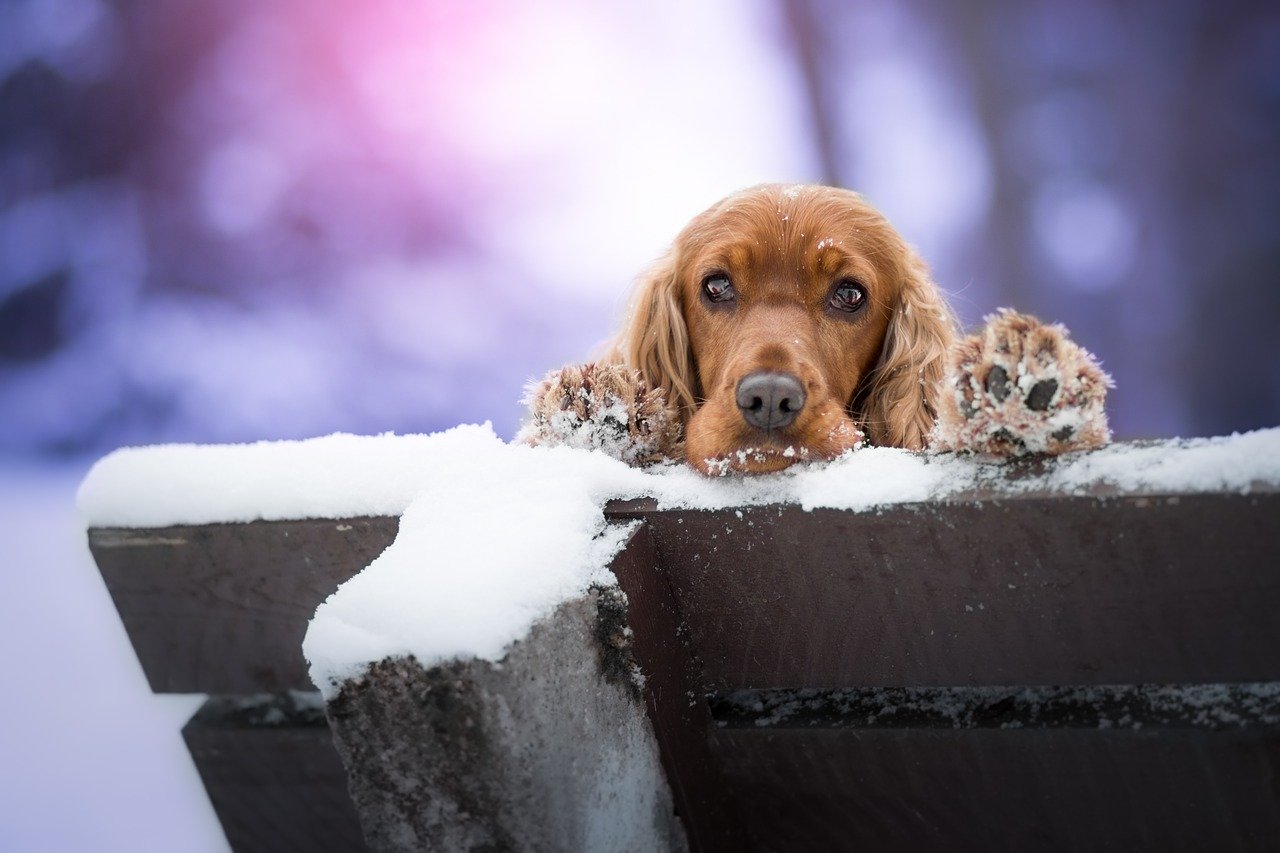
Another account of a selfless love of dogs comes from Australia, where the dog “is the aboriginal’s constant companion” among the Aranda hunter-gatherers:
The animals are kept by both man and woman–in a single wurley one might count as many as fifteen dogs living with the human occupants. … The natives have the dogs about them merely for the love they bear towards them; it is on account of the unreasonable amount of petting and pampering, received at the hands of their masters, that the dogs become so thoroughly useless. … They are so well looked after, and regularly steal so much from the general supplies of the camp, that they grow fat and lazy. When a dog seems to be off colour, or has been accidently hurt, it is nursed like a sick child; it is placed by the fireside, upon the best rug available, and covered with other rags, the natives themselves going without any covering. One might occasionally find a gin going so far as to even suckle a pup at her breast (Basedow 1925: 118-119).
While nursing a puppy may be a stretch for many human mothers, the recurring tales of these pampered pooches are not dissimilar from the primped and preened domestic furry friends that many of us know and love to spoil with affection.
A final ethnographic example of human-animal relationships comes from the Siberian Yakut love of horses, an animal they hold with the highest of esteem:
The Yakut love horses passionately; if their horses have been taken away they mourn for them, which is noticeable in songs and legends of the far north; their eyes always rest with delight on the beloved forms of horses, and their tongues gladly and solemnly sing their praises. I have never seen a Yakut scold a horse. Horses are as smart as people: one cannot insult them. Just see how they walk through the meadows; they never trample on something uselessly, the way cows do; they never spoil ricks of hay; they respect man’s labor! […] The horse is an animal with tender feelings: it knows how to evaluate good and evil! (Sieroszewski 1993: 478)
Yakut society would not be the same without horses. The following video illustrates the depth of this cultural significance in Yakut life as well as the centrality of their undying love and respect for their horses:
Challenging Universals
While a strong proclivity for the unconditional love of animals is obvious across cultures, there are some cases where a close relationship with certain animals, or the ownership of pets in general, is not desired. Some cultures may have ritual or superstitious reasons for fearing or disliking the idea of allowing an animal close to their homes or families. For instance, In Iran, dogs are seen as too polluted to keep in the Muslim home:
… [Muslims] regard dogs as unclean, and as a rule hunting dogs and sheep dogs are the only ones that are regarded as beneficial. [If] dogs are allowed in the house they should be kept in a room apart from where the family lives. On account of their “bad breath” they should not be allowed near where people eat. […] It is despicable (makrú) to keep a dog in the house, and anyone who does so will have his store of merit diminished by the value of one pilgrimage (Donaldson 1938: 159).
In addition, they are broadly feared as prognosticators of evil in Iranian folklore:
When dogs bark and donkeys bray it is a sign that devils are abroad, for dogs see and hear things which are denied to human senses, and at such times people should flee to God for protection. The howl of a dog is the sign of an earthquake, or pestilence, or the death of someone nearly related, for dogs are believed to be able to distinguish the Angel of Death (ibid.).
Lack of cleanliness and potential spiritual danger are just two cultural reasons why people may avoid domestic pets altogether. Another example from Iran found in eHRAF World Cultures draws a stark contrast between local village life in Iran and the way pets are treated in the United States. Among the Lur people, Friedl argues,
The idea of keeping pets for company is astonishing, revolting, or hilarious for people in Deh Koh. In government propaganda, with which people in Deh Koh agree in this case, pet cemeteries and money spent on food for dogs in the United States are much-cited signs of moral depravity of Westerners, who put the welfare of mere cats and dogs above the welfare of other, hungry, people. “In America, fathers love their dogs more than their children,” a fifteen-year-old girl told me earnestly. The absence of pets in Deh Koh thus makes local people better people than Westerners in their eyes. A few cases of older children being fond of a particular cat, or a young shepherd favoring a dog, or children wanting to pet a lamb, are known in every house but are not elaborated into patterns, and ignored as “childish.” Minoo, eight, was unconsolable [sic] after her uncle inadvertedly [sic] squished her pet kitten in the barn door. “Ah, children!” said her grandmother, irritated by the ruckus. “Cry for a cat!” It was a strange story in the neighborhood (1997: 259; emphasis added).
This clear example of an open disdain for pampered pets returns us to the study cited above wherein a majority of (Western) respondents chose to treat a wounded dog with greater compassion than an adult human in similar circumstances. Does such a moral stance show a predominantly Western bias because of how much Westerners have been conditioned to dote upon their furry companions? Do we love our pets too much and our fellow humans not enough?
Keep Digging
To continue this study and unravel new threads for your own research on the unconditional love of pets, use Advanced Search in eHRAF World Cultures or eHRAF Archaeology. Add OCM identifier 231 – Domesticated Animals to the Subjects box in order to search for ethnographic or archaeological documents containing mentions of pets across over 400 cultures or traditions. Add the keyword “love” to find cases of animal affection, as shown below:
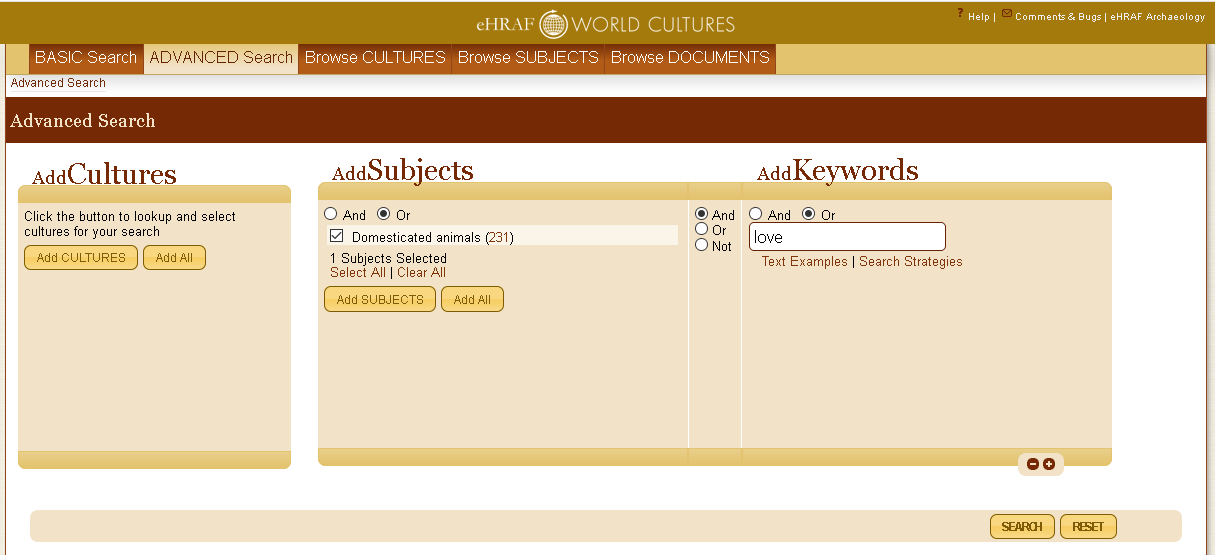
Not yet an eHRAF member? Free trials are available for academic institutions or individuals. Please contact us at hraf@yale.edu for more information.
References
Basedow, Herbert. 1925. “Australian Aboriginal.” Adelaide: F. W. Preece and sons. https://ehrafworldcultures.yale.edu/document?id=oi08-007.
Cipriani, Lidio, and D. Tayler Cox. 1966. “Andaman Islanders.” New York: Frederick A. Praeger, Inc. https://ehrafworldcultures.yale.edu/document?id=az02-011.
Dentan, Robert Knox. 1988. “Some Senoi Semai Dietary Restrictions: A Study Of Food Behavior In A Malay Hill Tribe.” Ann Arbor, Mich.: University Microfilms International. https://ehrafworldcultures.yale.edu/document?id=an06-007.
Friedl, Erika. 1997. “Children Of Deh Koh: Young Life In An Iranian Village.” Syracuse, N.Y.: Syracuse University Press. https://ehrafworldcultures.yale.edu/document?id=ma12-007.
Fulop, Marcos, and Mary Louise Bravo. 1954. “Aspects Of Tucano Culture: Cosmogony.” Revista Colombiana De Antropología 3: HRAF MS: 1–54 , plates [original: 97–137 , plates]. https://ehrafworldcultures.yale.edu/document?id=sq19-003.
Leach, E. 1964. Animal Categories and Verbal Abuse. In EH Lenneberg ed. New Directions in The Study of Language, Cambridge Mass.: MIT Press, pp. 28-63.
Gray, Peter B., and Sharon M. Young. 2010. “Human-Pet Dynamics in Cross-Cultural Perspective.” Anthrozoos 24: 17–30.
McKie, R. 2011. “Love of animals led to language and man’s domination of Earth”. The Guardian. Online: https://www.theguardian.com/science/2011/oct/02/anthropology-pat-shipman-animals-language Accessed: 2/3/2020
Rice, Michael. 1990. “Egypt’S Making: The Origins Of Ancient Egypt 5000-2000 Bc.” London: Routledge. https://ehrafarchaeology.yale.edu/document?id=mr55-009.
Salesius, Father. 1906. “Carolines Island Yap.” Berlin: Wilhelm Süsserot. https://ehrafworldcultures.yale.edu/document?id=or22-002.
Sieroszewski, Wacław. 1993. “Yakut: An Experiment In Ethnographic Research.” Moskva: Assotsiatsiia “Rossiiskaia polit. entsiklopediia.” https://ehrafworldcultures.yale.edu/document?id=rv02-001.
Woosley, Anne I., and Allan J. McIntyre. 1996. “Mimbres Mogollon Archaeology: Charles C. Di Peso’S Excavations At Wind Mountain.” Amerind Foundation, Inc. Archaeology Series. Dragoon, Ariz.: Amerind Foundation ; University of New Mexico Press. https://ehrafarchaeology.yale.edu/document?id=nt85-027.
Image credits: